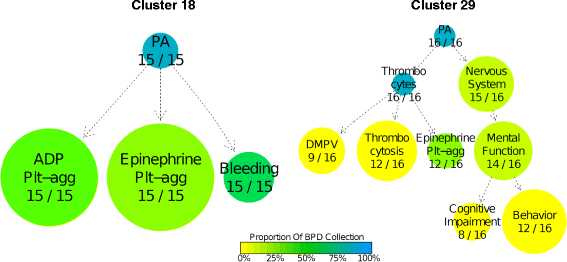Human phenotype ontology annotation and cluster analysis to unravel genetic defects in 707 cases with unexplained bleeding and platelet disorders
- PMID: 25949529
- PMCID: PMC4422517
- DOI: 10.1186/s13073-015-0151-5
Human phenotype ontology annotation and cluster analysis to unravel genetic defects in 707 cases with unexplained bleeding and platelet disorders
Abstract
Background: Heritable bleeding and platelet disorders (BPD) are heterogeneous and frequently have an unknown genetic basis. The BRIDGE-BPD study aims to discover new causal genes for BPD by high throughput sequencing using cluster analyses based on improved and standardised deep, multi-system phenotyping of cases.
Methods: We report a new approach in which the clinical and laboratory characteristics of BPD cases are annotated with adapted Human Phenotype Ontology (HPO) terms. Cluster analyses are then used to characterise groups of cases with similar HPO terms and variants in the same genes.
Results: We show that 60% of index cases with heritable BPD enrolled at 10 European or US centres were annotated with HPO terms indicating abnormalities in organ systems other than blood or blood-forming tissues, particularly the nervous system. Cases within pedigrees clustered closely together on the bases of their HPO-coded phenotypes, as did cases sharing several clinically suspected syndromic disorders. Cases subsequently found to harbour variants in ACTN1 also clustered closely, even though diagnosis of this recently described disorder was not possible using only the clinical and laboratory data available to the enrolling clinician.
Conclusions: These findings validate our novel HPO-based phenotype clustering methodology for known BPD, thus providing a new discovery tool for BPD of unknown genetic basis. This approach will also be relevant for other rare diseases with significant genetic heterogeneity.
Figures






References
-
- Rare Disease UK: Improving lives, optimising resources: a vision for the UK rare disease strategy. [http://www.raredisease.org.uk/documents/RD-UK-Strategy-Report.pdf]
-
- Bolton-Maggs PH, Perry DJ, Chalmers EA, Parapia LA, Wilde JT, Williams MD, et al. The rare coagulation disorders–review with guidelines for management from the United Kingdom Haemophilia Centre Doctors’ Organisation. Haemophilia. 2004;10:593–628. doi: 10.1111/j.1365-2516.2004.00944.x. - DOI - PubMed
-
- Quiroga T, Goycoolea M, Panes O, Aranda E, Martinez C, Belmont S, et al. High prevalence of bleeders of unknown cause among patients with inherited mucocutaneous bleeding. A prospective study of 280 patients and 299 controls. Haematologica. 2007;92:357–65. doi: 10.3324/haematol.10816. - DOI - PubMed
-
- Hayward CP, Pai M, Liu Y, Moffat KA, Seecharan J, Webert KE, et al. Diagnostic utility of light transmission platelet aggregometry: results from a prospective study of individuals referred for bleeding disorder assessments. J Thromb Haemost. 2009;7:676–84. doi: 10.1111/j.1538-7836.2009.03273.x. - DOI - PubMed
Grants and funding
LinkOut - more resources
Full Text Sources
Other Literature Sources
Molecular Biology Databases
Miscellaneous

